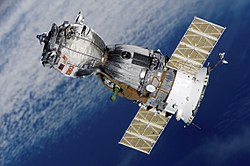This article needs additional citations for verification .(March 2013) |
| Operator | Rosaviakosmos |
|---|---|
| COSPAR ID | 1993-005A |
| SATCAT no. | 22319 |
| Mission duration | 179 days, 43 minutes, 45 seconds |
| Orbits completed | ~2,790 |
| Spacecraft properties | |
| Spacecraft | Soyuz 7K-STM No. 101 |
| Spacecraft type | Soyuz-TM |
| Manufacturer | NPO Energia |
| Launch mass | 7,150 kilograms (15,760 lb) |
| Crew | |
| Crew size | 2 up 3 down |
| Members | Gennadi Manakov Alexander Poleshchuk |
| Landing | Jean-Pierre Haigneré |
| Callsign | Вулка́н (Vulkan - Volcano) |
| Start of mission | |
| Launch date | 24 January 1993, 05:58:05 UTC |
| Rocket | Soyuz-U2 |
| End of mission | |
| Landing date | 22 July 1993, 06:41:50 UTC |
| Landing site | 140 kilometres (87 mi) S of Dzhezkazgan |
| Orbital parameters | |
| Reference system | Geocentric |
| Regime | Low Earth |
| Perigee altitude | 393 kilometres (244 mi) |
| Apogee altitude | 394 kilometres (245 mi) |
| Inclination | 51.6 degrees |
| Docking with Mir | |
| Docking date | 26 January 1993, 07:31:17 UTC |
| Undocking date | 22 July 1993, 3:00:30 UTC |
 Soyuz programme (Crewed missions) | |
Soyuz TM-16 was the sixteenth expedition to the Russian Space Station Mir. [1]
Contents
The Soyuz-TM crew transports (T - транспортный - Transportnyi - meaning transport, M - модифицированный - Modifitsirovannyi- meaning modified) were fourth generation (1986–2002) Soyuz spacecraft used for ferry flights to the Mir and ISS space stations. It added to the Soyuz-T new docking and rendezvous, radio communications, emergency and integrated parachute/landing engine systems. The new Kurs rendezvous and docking system permitted the Soyuz-TM to maneuver independently of the station, without the station making "mirror image" maneuvers to match unwanted translations introduced by earlier models' aft-mounted attitude control



